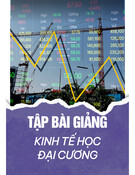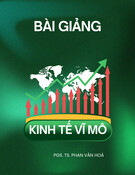N O
I
T
I
D E
MACROECONOMICS MACROECONOMICS N. Gregory Mankiw N. Gregory Mankiw Po we rPo int®® S lide s by Ro n Cro no vic h S lide s by Ro n Cro no vic h Po we rPo int
H T N E V E S
vĩ mô vĩ mô
11 C H A P T C H A P T E RE R Khoa h c Kinh t ọ Khoa h c Kinh t ọ
ế ế
© 2010 Worth Publishers, all rights reserved © 2010 Worth Publishers, all rights reserved
Trong chương này, sinh viên sẽ học Trong chương này, sinh viên sẽ học
Các v n đ nhà kinh t ề Các công c nhà kinh t
h c vĩ mô nghiên c u ấ ế ọ ứ
M t s khái ni m quan tr ng trong phân tích
h c vĩ mô s d ng ụ ế ọ ử ụ
ộ ố ệ ọ
vĩ mô
nh m t ư ộ
, nghiên c u n n kinh t ế ề ứ ng các v n đ nh : ư ấ ướ ề
Các vấn đề quan trọng trong kinh tế vĩ mô Kinh t vĩ mô ế t ng th , đ nh h ể ị ổ Đi u gì gây ra suy gi m? “Gói kích thích chính
ả
ph ” là gì và t i sao nó ho t đ ng? ạ ạ ộ ề ủ
nh h ấ ưở ng nh ư
Các v n đ c a th tr ề ủ ế
th nào đ n toàn b n n kinh t ? ế ng nhà ở ả ế
ụ ế ườ ộ
3
ị ườ ộ ề Thâm h t ngân sách chính ph là gì? Nó tác i lao đ ng, ng ộ i tr thu nh th nào? ườ ả đ ng đ n ng doanh nghi p và ng ệ i tiêu dùng, ư ế ủ ườ ế
CHAPTER 1 The Science of Macroeconomics
nh m t ư ộ
Các vấn đề quan trọng trong kinh tế vĩ mô Kinh t vĩ mô ế t ng th , đ nh h ể ị ổ
T i sao chi phí s ng ti p t c gia tăng? ố
ế ụ
ạ
ạ
ề
T i sao nhi u qu c gia nghèo? Chính sách nào ỏ
ố ng, kh i đói nghèo? ưở
giúp h tăng tr ọ
ng m i? Nó tác đ ng
ế
ụ
ộ đ n s giàu có c a qu c gia nh th nào?
Th nào là thâm h t th ươ ố
ạ ư ế
ự
ủ
ế
4
, nghiên c u n n kinh t ế ề ứ ng các v n đ nh : ư ấ ướ ề
CHAPTER 1 The Science of Macroeconomics
U.S. Real GDP per capita (2000 dollars)
9/11/2001
First oil price shock long-run upward trend…
Great Depression
Second oil price shock
World War II
U.S. Inflation Rate (% per year)
U.S. Unemployment Rate (% of labor force)
Tại sao phải học vĩ mô? vĩ mô nh h 1.Kinh t ế
ưở
ế
ả
ộ . ng đ n s giàu có c a xã h i
ự
ủ
c r i
e c r o
m e s
U.S. Unemployment and U.S. Unemployment and Property Crime Rates Property Crime Rates Social problems like homelessness, Social problems like homelessness, domestic violence, crime, and Property crimes domestic violence, crime, and (right scale) poverty are linked to the economy. poverty are linked to the economy.
f r o b a
l
l f
p e r
p o p u a
o
t i
t
o n
1 0 0
,
0 0 0
n e c r e p
Unemployment (left scale)
For example… For example…
vĩ mô tác đ ng đ n s th nh v
ng c a chính b n thân
Tại sao phải học vĩ mô? 2. Kinh t ự ị
ế
ế
ộ
ượ
ủ
ả
chúng ta. 5
5
r e
In most years, wage growth falls when unemployment is rising.
4
r e
3
3
1
2
1
-1
i l r a e s o m 2 1 m o r f
0
-3
i l r a e s o m 2 1 m o r f
-1
-5
e g n a h c t
-2
e g n a h c
-3
-7
n e c r e p
1965
1970
1975
1980
1985
1990
1995
2000
2005
unemployment rate
inflation-adjusted mean wage (right scale)
Tại sao phải học vĩ mô? 3. Kinh t
vĩ mô nh h ưở ế ả ng đ n k t qu b u c . ử ả ầ ế ế
Unemployment & inflation in election years
year
U rate
inflation rate
elec. outcome
1976
7.7%
5.8%
Carter (D)
1980
7.1%
13.5%
Reagan (R)
1984
7.5%
4.3%
Reagan (R)
1988
5.5%
4.1%
Bush I (R)
1992
7.5%
3.0%
Clinton (D)
1996
5.4%
3.3%
Clinton (D)
2000
4.0%
3.4%
Bush II (R)
2004
5.5%
3.3%
Bush II (R)
2008
7.2%
3.8%
Obama (D)
Các mô hình kinh tế
…là các mô hình đ n gi n hóa c a th c t ự ế ủ ả ơ ph c ứ
t không liên quan đ
c b
ế
c l ượ ượ
ỏ
t pạ Các chi ti
ế
ố
ế
…đ ể
ệ ủ ề ể ả
ề
ệ
ấ
ế
11
c s d ng đ ượ ử ụ Ch ra các m i quan h c a các bi n s ố ỉ Gi i thích hành vi c a n n kinh t ủ ả Đ xu t chính sách đ c i thi n n n kinh t ề
CHAPTER 1 The Science of Macroeconomics
ự ệ ư ỏ ế ả
Ví dụ: cung và cầu xe ô tô mới Ch ra các s ki n khác nhau nh w ng đ n ng xe ô tô nh th nào
Gi
ỉ giá và l ư ế ượ
ng c nh tranh: m i ng s th tr ả ử ị ườ
ạ ứ ỗ ể ườ ộ i mua và ế
bán quá nh đ n m c không th tác đ ng đ n giá th tr ỏ ế ng ị ườ
ầ
ng xe mà ng ng xe ng
ườ i s n xu t cung ng ườ ả
i mua c n ấ
ứ
ổ
12
ậ ầ
Các bi n sế
ố Qd = s l ố ượ Qs = s l ố ượ P = giá c a xe m i ớ ủ Y = t ng thu nh p Ps = giá thép (đ u vào) CHAPTER 1 The Science of Macroeconomics
Cầu xe ô tô
Hàm c u: Q
d = D (P,Y )
ầ Cho bi
13
t s l ng xe ng ế ố ượ quan đ n giá c a ô tô và t ng thu nh p ủ ế i tiêu dùng càn liên ườ ậ ổ
CHAPTER 1 The Science of Macroeconomics
Digression: functional notation
General functional notation
shows only that the variables are related.
Q
d = D (P,Y )
A specific functional form shows the precise quantitative relationship. Example:
A list of the variables that affect Q d
D (P,Y ) = 60 – 10P + 2Y
14
CHAPTER 1 The Science of Macroeconomics
demand equation:
The market for cars: Demand
Q
d = D (P,Y )
P Price of cars
D
The demand curve shows the relationship between quantity demanded and price, other things equal.
Q Quantity of cars
15
CHAPTER 1 The Science of Macroeconomics
The market for cars: Supply
S
Q
P Price of cars
supply equation: s = S (P,PS )
D
The supply curve shows the relationship between quantity supplied and price, other things equal.
Q Quantity of cars
16
CHAPTER 1 The Science of Macroeconomics
The market for cars: Equilibrium
S
P Price of cars
equilibrium price
D
Q Quantity of cars
equilibrium quantity
17
CHAPTER 1 The Science of Macroeconomics
demand equation:
The effects of an increase in income
Q
d = D (P,Y )
S
P Price of cars
P2 P1
An increase in income increases the quantity of cars consumers demand at each price…
D2
D1
Q1
Q2
Q Quantity of cars
…which increases the equilibrium price and quantity.
18
CHAPTER 1 The Science of Macroeconomics
The effects of a steel price increase
S2
Q
supply equation: s = S (P,PS )
S1
P Price of cars
P2 P1
An increase in Ps reduces the quantity of cars producers supply at each price…
D
Q2
Q1
Q Quantity of cars
…which increases the market price and reduces the quantity.
19
CHAPTER 1 The Science of Macroeconomics
Biến nội sinh và ngoại sinh
rđ ượ ị ủ c quy t đ nh ế ị ế n i sinh ộ
đ ế ngo i sinh ạ ị ủ ượ c quy t đ nh ế ị
Các giá tr c a bi n bên trong mô hình. Các giá tr c a bi n bên ngoài mô hình: các mô hình xem các giá tr và hành vi này cho tr
ị
Trong mô hình cung c u xe ô tô,
c . ướ
N i sinh:
ộ
ầ
P, Qd, Qs
Ngo i sinh: ạ
Y, Ps
20
CHAPTER 1 The Science of Macroeconomics
NOW YOU TRY: Supply and Demand
1. Write down demand and supply equations
for wireless phones; include two exogenous variables in each equation.
2. Draw a supply-demand graph for wireless
phones.
3. Use your graph to show how a change in
one of your exogenous variables affects the model’s endogenous variables.
Sử dụng nhiều mô hình
Không m t mô hình nào có th gi ể ả các v n đ chúng ta quan tâm.
i quy t t t c ế ấ ả
E.g., mô hình cung c u c a th tr
ộ ề ấ
Có thể cho chúng ta bi
ế ổ
ẽ ầ ng xe ô tô nh th nào.
đ ng đ n giá và l ế
ộ
ượ
t t ng c u gi m s tác ả ư ế
Không thể cho chúng ta bi
t t ế ạ
i sao t ng thu ổ
nh p gi m
ậ
ả
22
ng xe ô tô … ị ườ ủ ầ
CHAPTER 1 The Science of Macroeconomics
Sử dụng nhiều mô hình
ậ ề
Vì v y, chúng ta s h c nhi u mô hình khác ẽ ọ nhau đ nghiên c u các v n đ khác nhau ( ứ th t nghi p, l m phát, tăng tr ng dài h n). ạ
e.g., ể ấ
ề ưở ệ ấ ạ
Đ i v i m i mô hình m i, chúng ta nên nh ớ
ớ
ỗ thi ả
ả ờ
ề
ấ
ấ không
23
ố ớ Các gi t c a nó ế ủ Cái nào là bi n ngo i sinh, cái nào là n i sinh ộ ạ ế V n đ nào giúp chúng ta tr l i, v n đ nào ề
CHAPTER 1 The Science of Macroeconomics
Giá: linh hoạt vs. cố định
ế ả ằ
Cân b ng th tr ằ ề
ng ị ườ : m t gi ỉ thi ằ ộ ể ạ
t cho r ng giá linh ho t, đi u ch nh đ cân b ng cung và c u. ầ
c ng nh c ắ ứ ứ
Trong ng n h n, nhi u m c giá ạ ả ứ ậ ụ
ề ề ạ ắ – i v i s ạ ớ ự
ng
ể ầ
ồ
ộ danh nghĩa trong m t năm ho c nhi u h n
ỉ ổ ủ ợ ề
ề ươ ơ ề
ố ị ặ
Nhi u nhà xu t b n t p chí thay đ i giá 3-4 năm
ấ ả ạ
ổ
ề m t l n ộ ầ
24
đi u ch nh ch m ch p đ ph n ng l thay đ i c a cung ho c c u. Ví d : ặ Nhi u h p đ ng lao đ ng c đ nh ti n l ộ
CHAPTER 1 The Science of Macroeconomics
Giá: linh hoạt vs. cố định
Hành vi c a n n kinh t ủ ố ị
ph thu c m t ph n vào ộ ầ ộ ế
ạ
ắ
i thích đ
c:
ụ ạ
ể ả
ượ
t quá cung lao đ ng)
ấ
ệ
ượ
ộ
t
ể
ệ
ấ
ế c u không b ng cung, có th gi ầ Th t nghi p (v T i sao các doanh nghi p không th bán t ọ ả
ấ
ng cân b ng
ị ườ
ế
ạ
ằ
và n n kinh t
ạ c các hàng hóa h s n xu t ả N u giá linh ho t (dài h n), th tr ạ ph n ng s khác nhau ẽ
ả ứ
ế
ề
25
ề vi c giá c đ nh hay linh ho t: ệ N u giá c đ nh (ng n h n), ố ị ằ
CHAPTER 1 The Science of Macroeconomics
Outline of this book:
Introductory material (Chaps. 1 & 2) Classical Theory (Chaps. 3-6)
How the economy works in the long run, when prices are flexible
Growth Theory (Chaps. 7-8)
The standard of living and its growth rate over the very long run
Business Cycle Theory (Chaps. 9-14)
How the economy works in the short run, when prices are sticky
26
CHAPTER 1 The Science of Macroeconomics
Outline of this book:
Policy debates (Chaps. 15-16)
Microeconomic foundations (Chaps. 17-19)
Should the government try to smooth business cycle fluctuations? Is the government’s debt a problem?
27
Insights from looking at the behavior of consumers, firms, and other issues from a microeconomic perspective
CHAPTER 1 The Science of Macroeconomics
Chapter Summary Chapter Summary Macroeconomics is the study of the economy
Macroeconomists attempt to explain the
as a whole, including growth in incomes changes in the overall level of prices the unemployment rate
economy and to devise policies to improve its performance.
Chapter Summary Chapter Summary
Economists use different models to examine
Models with flexible prices describe the
different issues.
Macroeconomic events and performance arise from many microeconomic transactions, so macroeconomics uses many of the tools of microeconomics.
economy in the long run; models with sticky prices describe the economy in the short run.
Chapter 1: Problems and Applications p.16
1. Use the model of supply and demand to explain how a fall in the price of frozen yogurt would affect the price of ice cream and the quantity of ice cream sold. In your explanation, identify the exogenous and endogenous variables.
30
CHAPTER 1 The Science of Macroeconomics
Chapter 1: Problems and Applications p.16
2. How often does the price you pay for a haircut
change? What does your answer imply about the usefulness of market-clearing models for analyzing the market for haircuts?
3. What macroeconomics issues in Vietnam have
31
been in the news lately?



































